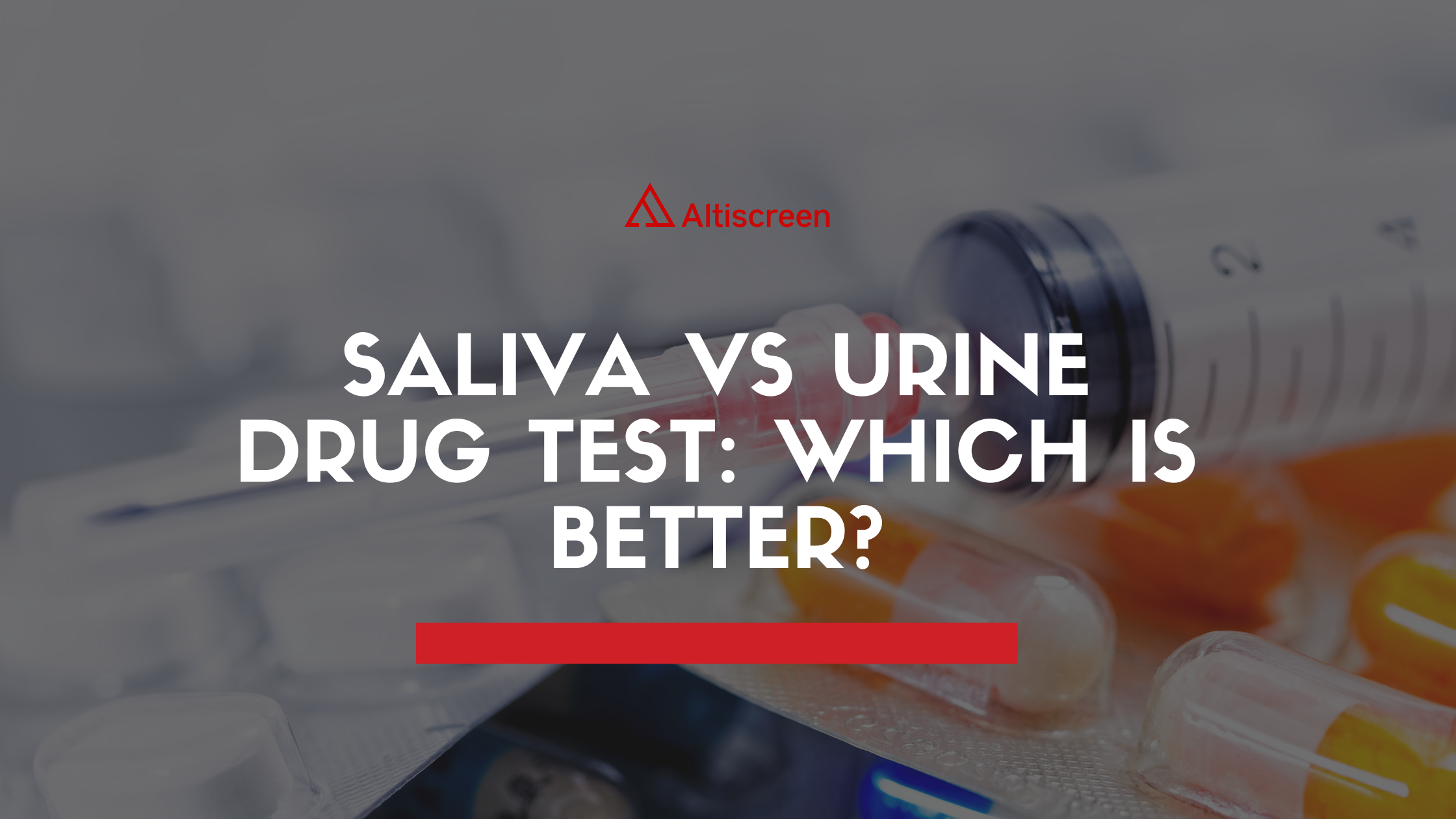Saliva vs Urine Drug Test: Which Is Better?
Drug testing is a vital tool for workplaces, law enforcement, and various programs to ensure safety and compliance. Two of the most common methods are saliva drug tests (oral fluid tests) and urine drug tests. Each method has its own strengths, limitations, and ideal uses. In this expert-driven guide, we explain the differences between saliva and urine drug tests, including how they work, their detection windows, accuracy, and when each is most appropriate. By the end, you will understand which is better in different scenarios and why neither test is universally superior in all situations.
Understanding Saliva Drug Testing (Oral Fluid Tests)
A saliva drug test involves analyzing a saliva sample (oral fluid) to detect the presence of drugs. This method is non-invasive and easy to administer on-site, often using a mouth swab to collect the sample. Because of its convenience, saliva testing can be done almost anywhere – even roadside by police or at a workplace – without needing special facilities. Results are usually quick, sometimes available within minutes for rapid on-site kits. Saliva tests excel at detecting very recent drug use. In fact, drugs can often be detected in saliva in under an hour after use and remain detectable for up to 48 hours. This means a saliva test is ideal for finding out if someone has used substances in the last day or two. For example, employers often favor oral fluid tests for post-incident or reasonable suspicion testing because it will show if an employee is currently or very recently under the influence. Likewise, law enforcement in some jurisdictions uses saliva tests for impaired driver screenings to catch recent drug use on the spot.
However, the shorter detection window of oral fluid tests is a double-edged sword. It makes them excellent for detecting immediate or very recent use, but it also means they may miss drugs used more than a couple of days earlier Someone who used drugs a week ago might test negative on a saliva test, even though trace evidence could still be found with other methods. Additionally, while saliva tests are considered highly accurate when properly administered, certain substances can be harder to detect in saliva. For instance, some benzodiazepines and amphetamines may not be as reliably detected by current oral fluid testing technology. In most cases, though, saliva drug screenings are highly sensitive and specific for a broad range of drugs, and any preliminary positive result can be confirmed by laboratory techniques for accuracy. Overall, saliva tests provide a swift and direct indication of recent drug use, aligning closely with potential impairment at the time of the test.
Understanding Urine Drug Testing
The urine drug test is the most established and widely used drug testing method. It requires a person to provide a urine sample, which is then analyzed for specific drugs and their metabolites (the substances produced after the body breaks down the drug). Urine testing has been a standard in workplace drug screening and other settings for decades, partly due to its broad detection window and well-developed testing protocols. A typical urine drug test can detect drug use over a longer period – often from a few days up to several weeks prior, depending on the substance and usage level. For example, occasional use of a drug might be detectable for a few days in urine, whereas chronic heavy use (like daily cannabis use) might be detectable for a couple of weeks or more. In general, urine tests can pick up drug usage that saliva tests can no longer detect. This longer window makes urine testing useful for pre-employment screenings and periodic testing, where the goal is to identify any drug use in the recent past rather than immediate impairment.
Urine testing is supported by established standards and regulations in many industries. In fact, many regulatory bodies historically mandated urine tests as the default. (For instance, the U.S. Department of Transportation exclusively used urine testing for safety-sensitive workers for many years.) Because of this long history, there is extensive data and experience on urine test reliability, and laboratories worldwide are well-equipped to process urine samples. Cost is another factor: urine tests are often relatively affordable, especially for large testing programs. This makes them a popular choice for companies conducting high-volume drug screening.
Despite these advantages, urine tests have some drawbacks. The collection process can be invasive or uncomfortable – it typically requires a private bathroom setting and sometimes direct observation by a same-gender technician to prevent tampering, which many people find embarrassing. Even when not observed, giving a urine sample involves privacy concerns that saliva tests largely avoid. Moreover, because the sample is provided by the person in a private setting, there is a risk of cheating or adulteration. Individuals have been known to attempt swapping in synthetic urine, diluting their sample, or adding adulterant chemicals to mask drugs in urine tests, especially if the collection is not strictly supervised. Testing labs do take countermeasures (like checking urine temperature, pH, and adulterant markers), but the fact remains that a urine sample offers more opportunity for tampering than a saliva swab. Lastly, urine tests generally do not indicate current impairment – a positive urine test only tells that a drug was used sometime in the last days or weeks, not whether the person is under the influence at that moment.
Detection Window: How Long Can Each Test Find Drugs?
One of the biggest differences between saliva and urine tests is the detection window – the timeframe during which evidence of drug use can be found in the sample. Broadly speaking, urine tests have a longer look-back period, while saliva tests capture a shorter, more immediate window. According to laboratory data, drugs in urine are generally detectable for about 1 to 7 days after use (and even longer for chronic heavy users of certain drugs), whereas drugs in saliva are typically detectable for only 5 to 48 hours after use. In other words, a urine test might detect drug use from several days ago that a saliva test would miss. For example, tetrahydrocannabinol (THC from cannabis) might be detectable in urine for a week or more in a frequent user, but a saliva test might only catch it within a day or two of the last use.
On the flip side, saliva tests can register a drug much sooner after ingestion than urine tests. It often takes time for drugs to metabolize and be excreted into urine. Saliva, by contrast, can directly contain the parent drug or its metabolites almost immediately via the bloodstream or mouth residues. As a result, a saliva test can sometimes detect a substance within minutes to an hour of use, making it extremely useful for determining if someone has recently used a drug. Urine tests usually cannot detect a drug that was used only an hour or two ago because the substance has not fully passed into the urine yet; they are better at catching use from the prior day or earlier. This distinction is crucial for safety-sensitive situations. If a worker appears impaired, an oral fluid test provides a near-real-time snapshot of drugs in their system, whereas a urine test might come back negative simply because of the time lag, even if that person was indeed using drugs very recently.
In summary, saliva testing covers the last 24-48 hours of drug use in most cases, aligning well with detecting current impairment, while urine testing covers a broader timeframe (several days or more) and can unveil a history of drug use over the past week or so. Neither window is “better” universally; it depends on what you need to know. If you’re concerned about immediate impairment – say, after a workplace accident or for roadside drug driving checks – the short window of saliva tests is an advantage. If you’re more concerned about general drug use habits (such as an employer screening for any recent drug use, or an addiction treatment program monitoring abstinence over time), the longer window of urine tests is beneficial.
Accuracy and Reliability of Results
When properly administered and confirmed in a laboratory, both saliva and urine drug tests are highly accurate and reliable. False positives or negatives are rare and usually addressed through advanced confirmatory methods such as GC-MS or LC-MS/MS. Saliva tests can achieve high sensitivity, especially for recent drug use, though certain drugs like benzodiazepines or amphetamines may be less detectable in oral fluid due to lower concentrations. Urine tests, by contrast, often identify drug metabolites, which remain in the system longer but may not reflect current impairment.
The reliability of both methods can be affected by external factors. Eating or drinking before a saliva test can dilute the sample, while excessive fluid intake can do the same for urine. Modern testing kits include adulteration checks to flag tampering. Ultimately, the main difference in reliability is tied to timing: saliva tests capture recent use more accurately, while urine tests detect use over a longer period. Each method is most effective when aligned with its intended purpose.
Collection Process and Potential for Cheating
One of the most practical differences between saliva and urine drug tests lies in how samples are collected and the potential for tampering. Saliva collection is simple, quick, and fully observable. A technician places a swab inside the person’s mouth—usually under the tongue or along the gums—while watching the entire process. This direct observation makes it extremely difficult to cheat or substitute a sample. Because oral fluid testing doesn’t require a private setting or gender-specific supervision, it’s also seen as more respectful and less intrusive, especially in workplaces or roadside situations. For individuals with anxiety or medical difficulties related to urination, oral fluid testing is generally much easier to undergo. The only occasional issue—dry mouth—can usually be resolved by waiting a few minutes or taking a small sip of water.
Urine testing, by contrast, involves more stringent collection protocols. It typically requires access to a restroom, and sometimes direct observation by a test administrator to prevent sample substitution or adulteration. Despite these measures, urine tests are still more susceptible to cheating. People may attempt to use synthetic urine, swap in a clean sample, or add chemicals to alter the results. Laboratories counteract this with adulteration checks—monitoring temperature, pH, creatinine levels, and other indicators—but the fact remains: the process leaves room for tampering because the sample is given in partial or complete privacy.
For that reason, many experts consider saliva testing more secure from manipulation. It’s not just more difficult to cheat, but also easier to implement in real-time settings like workplace incidents or roadside screenings. Although urine tests remain the traditional standard in many institutions, oral fluid testing is increasingly recognized for its security, simplicity, and reliability. As technology improves, more organizations are moving toward saliva-based testing protocols.
Use Cases: When to Choose Saliva or Urine Drug Testing
The choice between saliva and urine drug testing depends entirely on the context of the screening and the timeframe being assessed. Saliva testing is designed to detect recent drug intake, typically within the first 6 to 24 hours depending on the substance. This makes it especially suitable for situations where immediate impairment matters: roadside checks for drug-impaired drivers, post-incident testing in the workplace, and spot checks in high-risk industries. Oral fluid contains the parent drug itself, not just its metabolites, offering a more direct reflection of active consumption and the likelihood of impairment at the time of testing.
Urine testing, by contrast, is used to identify drug use that may have occurred several days prior—sometimes up to a week or more in chronic users. This extended detection window is made possible by the presence of drug metabolites, which remain in the system long after the effects of the substance have worn off. Urine testing is therefore more appropriate for pre-employment drug screenings, ongoing monitoring programs, or any setting where recent substance history is more relevant than immediate influence.
Urine has historically been the gold standard in regulatory environments, particularly in sectors like aviation, logistics, or transport. That said, saliva testing is now accepted as an official alternative in many jurisdictions. Its ability to prevent sample adulteration, allow on-site collection, and reveal recent usage has positioned it as a reliable method for time-sensitive scenarios.
In practice, both testing matrices are often used together. Saliva testing covers immediate risk by confirming real-time or recent drug use, while urine testing provides a broader view of past consumption. This dual approach enables employers and institutions to apply a more complete and context-aware drug screening policy.
For situations requiring a rapid, secure, and non-invasive method to detect current drug use, saliva testing offers clear advantages. When the goal is to monitor abstinence, uncover repeat usage, or assess historical patterns, urine remains the more effective solution. Each has its role depending on the operational need and the window of detection required.
Which Test Is Better: Saliva or Urine?
There is no universally “better” test. Each method excels in specific situations. Saliva tests are best for detecting very recent drug use, often within minutes to 24 hours. Urine tests, in contrast, detect substances over a longer timeframe, sometimes up to several days, especially for lipid-soluble drugs that linger in the body.
Saliva for Immediate Detection
Oral fluid tests identify the parent drug, which reflects actual consumption and possible impairment. This makes saliva testing ideal for roadside checks, workplace incidents, or random screening where real-time risk matters. Since the collection is directly observed, it significantly reduces cheating or substitution attempts.
Urine for Historical Use
Urine tests primarily detect metabolites, offering a longer detection window but not necessarily correlating with current impairment. This makes them more suitable for pre-employment screenings, compliance testing, or monitoring abstinence. Their broad regulatory acceptance also explains their widespread use.
Use Both When Possible
In many cases, combining both methods provides the best coverage: saliva for immediate risk, urine for broader history. This dual strategy is increasingly used in safety-sensitive industries, rehab programs, and compliance settings.
Conclusion
Saliva and urine drug tests are not in competition—they are complementary tools designed to serve different needs. Saliva testing brings speed, convenience, and insight into recent or real-time drug use, making it indispensable in urgent or on-site situations. Urine testing, with its broader detection window, remains the go-to for verifying substance use over the past several days, especially in routine or regulatory contexts.
Choosing the right method depends on what you need to measure: recent influence or past behavior. In many cases, combining both offers the most complete and reliable picture. Whether you’re an employer, clinician, or individual, understanding the strengths and limits of each test ensures better decisions, improved safety, and greater trust in the results.





